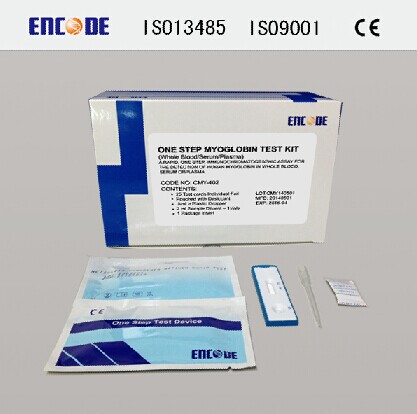INTENDED USE
The Myoglobin Rapid Test Device (Whole Blood/Serum/Plasma) is a rapid chromatographic immunoassay for the qualitative detection of human Myoglobin in whole blood, serum or plasma as an aid in the diagnosis of myocardial infarction (MI).
INTRODUCTION
Myoglobin (MYO) is a heme-protein normally found in skeletal and cardiac muscle with a molecular weight of 17.8 kDa.It constitutes about 2 percent of total muscle protein and is responsible with transporting oxygen within the muscle cells.1 When the muscle cells are damaged, Myoglobin is released to the blood rapidly due to its relatively small size. Following the death of tissue associated with MI, Myoglobin is one of the first markers to rise above normal levels. The level of Myoglobin increases measurably above baseline within 2-4 hours post-infarct, peaking at 9-12 hours, and returning to baseline within 24-36 hours.2,3 A number of reports suggest the measurement of Myoglobin as a diagnostic aid in confirming the absence of myocardial infarction with negative predictive values of up to 100% reported at certain time periods after onset of symptoms.4
The One Step Myoglobin Rapid Test Device (Whole Blood/Serum/Plasma) is a simple test utilizing a combination of anti-Myoglobin antibody coated particles and capture reagent to detect Myoglobin in whole blood, serum or plasma. The minimum detection level is 50 ng/mL.
KIT COMPONENTS
The test contains anti Myoglobin antibody coated particles and capture reagent coated on the membrane.
Materials Provided
1.Test devices
a.Droppers
b.Buffer
2.Package insert
PROCEDURE
Allow the test, specimen and/or controls to reach room temperature (15~30°C) prior to testing.
1.Bring the pouch to room temperature before opening it. Remove the test device from the sealed pouch and use it as soon as possible.
2.Place the test device on a clean and level surface.
For Serum or Plasma specimens:
Hold the dropper vertically and transfer 2 drops of serum or plasma (approximately 50 mL) to the specimen well (S) of the test device, then add 1 drop of buffer and start the timer.
For Venipuncture Whole Blood specimens:
Hold the dropper vertically and transfer 2 drops of venipuncture whole blood (approximately 50 mL) to the specimen well (S) of the test device, then add 1 drop of buffer and start the timer.
For Fingerstick Whole Blood specimens:
- To use a capillary tube: Fill the capillary tube and transfer approximately 50 mL of fingerstick whole blood specimen to the specimen well (S) of the test device, then add 1 drop of buffer and start the timer.
- To use hanging drops: Allow 2 hanging drops of fingerstick whole blood specimen (approximately 50 mL) to fall into the center of the specimen well (S) on the test device, then add 1 drop of buffer and start the timer.
3.Wait for the colored line(s) to appear. Read results at 10 minutes. Do not interpret results after 20 minutes.

INTERPRETATION OF RESULTS
(Please refer to the illustration above)
POSITIVE:* Two distinct colored lines appear. One colored line should be in the control line region (C) and another apparent colored line should be in the test line region (T).
*NOTE: The intensity of the color in the test line region (T) will vary depending on the concentration of Myoglobin present in the specimen. Therefore, any shade of color in the test line region (T) should be considered positive.
NEGATIVE: One colored line appears in the control line region (C). No line appears in the test line region (T).
INVALID: Control line (C) fails to appear. Insufficient specimen volume or incorrect procedural techniques are the most likely reasons for control line failure. Review the procedure and repeat the test with a new test. If the problem persists, discontinue using the test kit immediately and contact your local distributor.
bio-equip.cn





